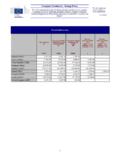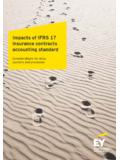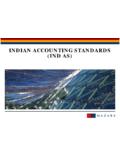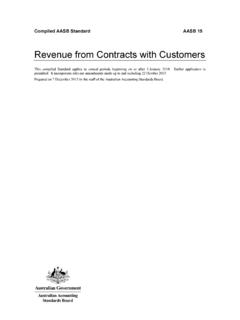Transcription of International Accounting Standard 39 Financial …
1 EC staff consolidated version as of 18 February 2011. FOR INFORMATION PURPOSES ONLY. International Accounting Standard 39. Financial Instruments: Recognition and Measurement Objective 1 The objective of this Standard is to establish principles for recognising and measuring Financial assets, Financial liabilities and some contracts to buy or sell non- Financial items. Requirements for presenting information about Financial instruments are in IAS 32 Financial Instruments: Presentation. Requirements for disclosing information about Financial instruments are in ifrs 7 Financial Instruments: Disclosures. Scope 2 This Standard shall be applied by all entities to all types of Financial instruments except: (a) those interests in subsidiaries, associates and joint ventures that are accounted for under IAS 27 Consolidated and Separate Financial Statements, IAS 28 Investments in Associates or IAS 31 Interests in Joint Ventures.
2 However, entities shall apply this Standard to an interest in a subsidiary, associate or joint venture that according to IAS 27, IAS 28 or IAS 31 is accounted for under this Standard . Entities shall also apply this Standard to derivatives on an interest in a subsidiary, associate or joint venture unless the derivative meets the definition of an equity instrument of the entity in IAS 32. (b) rights and obligations under leases to which IAS 17 Leases applies. However: (i) lease receivables recognised by a lessor are subject to the derecognition and impairment provisions of this Standard (see paragraphs 15 37, 58, 59, 63 65 and Appendix A paragraphs AG36 AG52 and AG84 AG93);. (ii) finance lease payables recognised by a lessee are subject to the derecognition provisions of this Standard (see paragraphs 39 42 and Appendix A paragraphs AG57 AG63); and (iii) derivatives that are embedded in leases are subject to the embedded derivatives provisions of this Standard (see paragraphs 10 13 and Appendix A paragraphs AG27 AG33).
3 (c) employers' rights and obligations under employee benefit plans, to which IAS 19 Employee Benefits applies. (d) Financial instruments issued by the entity that meet the definition of an equity instrument in IAS 32 (including options and warrants) or that are required to be classified as an equity instrument in accordance with paragraphs 16A and 16B or paragraphs 16C and 16D of IAS. However, the holder of such equity instruments shall apply this Standard to those instruments, unless they meet the exception in (a) above. (e) rights and obligations arising under (i) an insurance contract as defined in ifrs 4 Insurance Contracts, other than an issuer's rights and obligations arising under an insurance contract that meets the definition of a Financial guarantee contract in paragraph 9, or (ii) a contract that is within the scope of ifrs 4 because it contains a discretionary participation feature.
4 However, this Standard applies to a derivative that is embedded in a contract within the scope of ifrs 4 if the derivative is not itself a contract within the scope of ifrs 4 (see paragraphs 10 13 and Appendix A paragraphs AG27 AG33 of this Standard ). Moreover, if an issuer of Financial guarantee contracts has previously asserted explicitly that it regards such contracts as insurance contracts and has used Accounting applicable to insurance 1. EC staff consolidated version as of 18 February 2011. FOR INFORMATION PURPOSES ONLY. contracts, the issuer may elect to apply either this Standard or ifrs 4 to such Financial guarantee contracts (see paragraphs AG4 and AG4A). The issuer may make that election contract by contract , but the election for each contract is irrevocable. (f) [deleted]. (g) any forward contract between an acquirer and a selling shareholder to buy or sell an acquiree that will result in a business combination at a future acquisition date.
5 The term of the forward contract should not exceed a reasonable period normally necessary to obtain any required approvals and to complete the transaction. (h) loan commitments other than those loan commitments described in paragraph 4. An issuer of loan commitments shall apply IAS 37. Provisions, Contingent Liabilities and Contingent Assets to loan commitments that are not within the scope of this Standard . However, all loan commitments are subject to the derecognition provisions of this Standard (see paragraphs 15 42 and Appendix A paragraphs AG36 AG63). (i) Financial instruments, contracts and obligations under share-based payment transactions to which ifrs 2 Share-based Payment applies, except for contracts within the scope of paragraphs 5 7 of this Standard , to which this Standard applies. (j) rights to payments to reimburse the entity for expenditure it is required to make to settle a liability that it recognises as a provision in accordance with IAS 37, or for which, in an earlier period, it recognised a provision in accordance with IAS 37.
6 3 [Deleted]. 4 The following loan commitments are within the scope of this Standard : (a) loan commitments that the entity designates as Financial liabilities at fair value through profit or loss. An entity that has a past practice of selling the assets resulting from its loan commitments shortly after origination shall apply this Standard to all its loan commitments in the same class. (b) loan commitments that can be settled net in cash or by delivering or issuing another Financial instrument. These loan commitments are derivatives. A loan commitment is not regarded as settled net merely because the loan is paid out in instalments (for example, a mortgage construction loan that is paid out in instalments in line with the progress of construction). (c) commitments to provide a loan at a below-market interest rate. Paragraph 47(d) specifies the subsequent measurement of liabilities arising from these loan commitments.
7 5 This Standard shall be applied to those contracts to buy or sell a non- Financial item that can be settled net in cash or another Financial instrument, or by exchanging Financial instruments, as if the contracts were Financial instruments, with the exception of contracts that were entered into and continue to be held for the purpose of the receipt or delivery of a non- Financial item in accordance with the entity's expected purchase, sale or usage requirements. 6 There are various ways in which a contract to buy or sell a non- Financial item can be settled net in cash or another Financial instrument or by exchanging Financial instruments. These include: (a) when the terms of the contract permit either party to settle it net in cash or another Financial instrument or by exchanging Financial instruments;. (b) when the ability to settle net in cash or another Financial instrument, or by exchanging Financial instruments, is not explicit in the terms of the contract , but the entity has a practice of settling similar contracts net in cash or another Financial instrument or by exchanging Financial instruments (whether with the counterparty, by entering into offsetting contracts or by selling the contract before its exercise or lapse).
8 (c) when, for similar contracts, the entity has a practice of taking delivery of the underlying and selling it within a short period after delivery for the purpose of generating a profit from short-term fluctuations in price or dealer's margin; and (d) when the non- Financial item that is the subject of the contract is readily convertible to cash. 2. EC staff consolidated version as of 18 February 2011. FOR INFORMATION PURPOSES ONLY. A contract to which (b) or (c) applies is not entered into for the purpose of the receipt or delivery of the non- Financial item in accordance with the entity's expected purchase, sale or usage requirements and, accordingly, is within the scope of this Standard . Other contracts to which paragraph 5 applies are evaluated to determine whether they were entered into and continue to be held for the purpose of the receipt or delivery of the non- Financial item in accordance with the entity's expected purchase, sale or usage requirements and, accordingly, whether they are within the scope of this Standard .
9 7 A written option to buy or sell a non- Financial item that can be settled net in cash or another Financial instrument, or by exchanging Financial instruments, in accordance with paragraph 6(a) or (d) is within the scope of this Standard . Such a contract cannot be entered into for the purpose of the receipt or delivery of the non- Financial item in accordance with the entity's expected purchase, sale or usage requirements. Definitions 8 The terms defined in IAS 32 are used in this Standard with the meanings specified in paragraph 11 of IAS 32. IAS 32 defines the following terms: Financial instrument Financial asset Financial liability equity instrument and provides guidance on applying those definitions. 9 The following terms are used in this Standard with the meanings specified: Definition of a derivative A derivative is a Financial instrument or other contract within the scope of this Standard (see paragraphs 2 7) with all three of the following characteristics: (a) its value changes in response to the change in a specified interest rate, Financial instrument price, commodity price, foreign exchange rate, index of prices or rates, credit rating or credit index, or other variable, provided in the case of a non- Financial variable that the variable is not specific to a party to the contract (sometimes called the underlying').
10 (b) it requires no initial net investment or an initial net investment that is smaller than would be required for other types of contracts that would be expected to have a similar response to changes in market factors; and (c) it is settled at a future date. Definitions of four categories of Financial instruments A Financial asset or Financial liability at fair value through profit or loss is a Financial asset or Financial liability that meets either of the following conditions. (a) It is classified as held for trading. A Financial asset or Financial liability is classified as held for trading if: (i) it is acquired or incurred principally for the purpose of selling or repurchasing it in the near term;. (ii) on initial recognition it is part of a portfolio of identified Financial instruments that are managed together and for which there is evidence of a recent actual pattern of short-term profit-taking; or 3.














